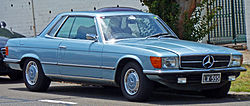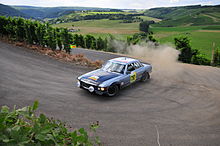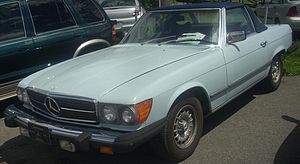- Mercedes-Benz R107 and C107
-
Mercedes-Benz R107 (SL) and C107 (SLC) 
Production SL: 1971–1989
SLC: 1971–1981
300,175 built[1]
SL: 237,287
SLC: 62,888Assembly Sindelfingen, Germany Predecessor Mercedes-Benz W113 (SL)
Mercedes-Benz W111 (SLC)Successor Mercedes-Benz R129 (SL)
Mercedes-Benz C126 (SLC)Body style Roadster
CoupeLayout FR layout Engine I6
2.8L (SL, SLC)
3.0L (SL)
V8
3.5L (SL, SLC)
3.8L (SL, SLC)
4.2L (SL)
4.5L (SL, SLC)
5.0L (SL, SLC)
5.6L (SL)Transmission Automatic
3 speed (SL, SLC)
4 speed (SL, SLC)
Manual
4 speed (SL)
5 speed (SL)The Mercedes-Benz R107 and C107 automobiles were produced from 1971 through 1989, being the second longest single series ever produced by the Mercedes, after the G-Class. They were sold under the SL (R107) and SLC (C107) model names. The R107 replaced the W113 SL-Class in 1972 and was replaced by the R129 SL-Class in 1989. The SLC replaced the W111 Coupé in 1971 and was replaced by the C126 S-class coupe in 1981.
Contents
Model history
The R107 took the chassis components of the mid size Mercedes-Benz W114 model and mated them to the larger engines from the S-Class (W116).
The SL variant was a 2-seat convertible/roadster with standard soft top and hardtop and optional folding seats for the rear bench. The SLC (C107) derivative was a 2 door hardtop coupe with normal rear seats. The SLC is commonly referred to as an 'SL coupe', but in reality it was an S-class coupe, replacing the former saloon-based 280/300 SE coupé in Mercedes lineup. The SLC was replaced earlier than the SL, in 1981, with a much larger model, the 380 SEC based on the new S class.
Volume production of the first R107 car, the 350 SL, started in April, 1971 alongside the last of the W113 cars; the 350 SLC followed in October. Sales in North America began in 1972, and cars wore the name 350 SL, but had a larger 4.5L V8 (and were renamed 450 SL/SLC for model year 1973); the big V8 became available on other markets with the official introduction of the 450 SL/SLC on non-North American markets in March, 1973. US cars sold from 1972 through 1975 used the Bosch D Jetronic fuel injection system, an early electronic engine management system.
From July, 1974 both SL and SLC could also be ordered with a fuel-injected 2.8L straight-6 as 280 SL and SLC. US models sold from 1976 through 1979 used the Bosch K Jetronic system, an entirely mechanical fuel injection system. All US models used the 4.5 liter engine, and were called 450 SL/SLC.
In September, 1977 the 450 SLC 5.0 joined the line. This was a special version of the big coupé featuring a new all-aluminum five-liter V8, aluminum alloy doors, hood and trunk lid - and a black rubber rear spoiler.
Starting in 1980, US cars were equipped with lambda control, which varied the air/fuel mixture based on feedback from an oxygen sensor. The 350, 450 and 450 SLC 5.0 models (like the 350 and 450 SL) were discontinued in 1980 with the introduction of the 380 and 500 SLC in March, 1980. At the same time, the cars received a very mild make-over; the 3-speed automatic was replaced by a four-speed unit, the 280 models came with a standard 5-speed (formerly a 4-speed) manual and all five-liter cars gained a black rear spoiler lip.
The 280, 380 and 500 SLC were discontinued in 1981 with the introduction of the 126 series 380 and 500 SEC coupes. A total of 62,888 SLCs had been manufactured over a ten year period of which just 1,636 were the 450 SLC-5.0 and 1,133 were the 500 SLC. Both these models are sought by collectors today. With the exception of the SL65 AMG Black Series, the SLC remains the only fixed roof Mercedes-Benz coupe based on a roadster rather than a sedan.
Following the discontinuation of the SLC in September, 1981, the 107 series continued initially as the 280, 380 and 500 SL. At this time, the V8 engines were re-tuned for greater efficiency, lost a few hp and consumed less fuel, helped by substantially numerically shorter axle ratios (that went from 3.27:1 to 2.47:1 for the 380 SL and from 2.72:1 to 2.27:1 for the 500 SL). From September, 1985 the 280 SL was replaced by a new 300 SL, and the 380 SL by a 420 SL; the 500 SL continued and a 560 SL was introduced for certain extra-European markets, most notably the USA. Also in 1985, the Bosch KE Jetronic was fitted. The KE Jetronic system varied from the earlier, all mechanical system by the introduction of a more modern engine management "computer", which controlled idle speed, fuel rate, and air/fuel mixture. The final car of the 18 years running 107 series - 500 SL painted Astral Silver was built on August 4, 1989 and it currently resides in the Mercedes-Benz museum in Stuttgart, Germany.
Models timeline
Mercedes-Benz R107 and C107 timeline Type 1970s 1980s 0 1 2 3 4 5 6 7 8 9 0 1 2 3 4 5 6 7 8 9 350 SL 350 SLC 350/450 SL (US) 350/450 SLC (US) 450 SL 450 SLC 280 SL 280 SLC 380 SL 380 SLC 500 SL 500 SLC 380 SL (US) 380 SLC (US) 300 SL 420 SL 560 SL (US) Technical data
Technical data Mercedes-Benz R107/C107 (non-USA models)[2] (Manufacturer's figures except where stated)Mercedes-Benz 280 SL/SLC* 300 SL 350 SL/SLC** 380 SL/SLC† 420 SL 450 SL/SLC*** 500 SL/SLC****‡ Produced: MY 1974–1985 (SL)
MY 1974–1981 (SLC)MY 1985–1989 MY 1971–1980 MY 1980–1985 (SL)
MY 1980–1981 (SLC)MY 1985–1989 MY 1973–1980 MY 1980–1989 (SL)
MY 1980–1981 (SLC)Engine: 6-cylinder-inline engine (four-stroke), front-mounted 90° 8-cylinder-V engine (four-stroke), front-mounted Bore x Stroke: 86 mm x 78.8 mm 88.5 mm x 80.25 mm 92 mm x 65.8 mm 92 mm x 71.8 mm 92 mm x 78.9 mm 92 mm x 85 mm 96.5 mm x 85 mm Displacement: 2746 cc 2962 cc 3499 cc 3818 cc 4196 cc 4520 cc 4973 cc Max. Power @ rpm: 185 PS (136 kW; 182 hp) @ 6000 188 PS (138 kW; 185 hp) @ 5700 200 PS (150 kW; 200 hp) @ 5800 218 PS (160 kW; 215 hp) @ 5500 218 PS (160 kW; 215 hp) @ 5200 225 PS (165 kW; 222 hp) @ 5000 240 PS (180 kW; 240 hp) @ 5000 Max. Torque @ rpm: 238 N·m (176 lb·ft) @ 4500 255 N·m (188 lb·ft) @ 4400 286 N·m (211 lb·ft) @ 4000 299 N·m (221 lb·ft) @ 4000 392 N·m (289 lb·ft) @ 3750 377 N·m (278 lb·ft) @ 3000 402 N·m (296 lb·ft) @ 3200 Compression Ratio: 9.0: 1 9.2: 1 9.5: 1 9.0: 1 9.0: 1 8.8: 1 9.0: 1 Fuel feed: Fuel injection, Bosch D- or K-Jetronic, from 1985 KE-Jetronic Fuel tank capacity: 90 L (23.8 US gal; 19.8 imp gal), from 1985: 85 L (22.5 US gal; 18.7 imp gal) Valvetrain: DOHC, duplex chain SOHC, duplex chain Cooling: Water Gearbox: 4- or 5-speed manual
standard on 380/420/450/500: 3-speed automatic, from 1980: 4-speed automatic
rear wheel driveElectrical system: 12 volt Front suspension: Double wishbones, coil springs, additional rubber springs, stabilising bar Rear suspension:: Diagonal swing axle, coil springs, stabilising bar Brakes: Disc brakes (Ø 278 mm front, 279 mm rear; from 1985: 284/279 mm), power assisted
ABS from 1980 on request or standardSteering: Recirculating ball steering Body structure: Sheet steel, unibody construction Dry weight: SL: 1,560 kg (3,400 lb)
SLC: 1,610 kg (3,500 lb)1,530 kg (3,400 lb) SL: 1,600 kg (3,500 lb)
SLC: 1,650 kg (3,600 lb)SL: 1,640 kg (3,600 lb)
SLC: 1,690 kg (3,700 lb)1,600 kg (3,500 lb) SL: 1,640 kg (3,600 lb)
SLC: 1,690 kg (3,700 lb)SL: 1,600 kg (3,500 lb)
SLC: 1,570 kg (3,500 lb)Loaded weight: SL: 1,920 kg (4,200 lb)
SLC: 2,040 kg (4,500 lb)1,930 kg (4,300 lb) SL: 1,960 kg (4,300 lb)
SLC: 2,050 kg (4,500 lb)SL: 1,960 kg (4,300 lb)
SLC: 2,050 kg (4,500 lb)2,020 kg (4,500 lb) SL: 2,015 kg (4,440 lb)
SLC: 2,095 kg (4,620 lb)SL: 1,960 kg (4,300 lb)
SLC: 2,005 kg (4,420 lb)Track front/
rear:1,452 mm (57.2 in) 1,440 mm (57 in)
from 1985: 1,461 mm (57.5 in) 1,465 mm (57.7 in)Wheelbase: SL: 2,460 mm (97 in)
SLC: 2,820 mm (111 in)Length: SL: 4,390 mm (173 in)
SLC: 4,750 mm (187 in)Width: 1,790 mm (70 in) Height: SL: 1,300 mm (51 in)
SLC: 1,330 mm (52 in)Tire sizes: 185HR14 205/65VR15 205/70VR14 205/70VR14 205/65VR15 205/70VR14 205/70VR14 Top speed: 207 km/h (129 mph) 210 km/h (130 mph) 212 km/h (132 mph) 215 km/h (134 mph) 210 km/h (130 mph) 218 km/h (135 mph) 215 km/h (134 mph) Fuel Consumption (estimates): 15.5 litres per 100 kilometres (18.2 mpg-imp; 15.2 mpg-US) 14.5 litres per 100 kilometres (19.5 mpg-imp; 16.2 mpg-US) 18.5 litres per 100 kilometres (15.3 mpg-imp; 12.7 mpg-US) 18.5 litres per 100 kilometres (15.3 mpg-imp; 12.7 mpg-US) 15.5 litres per 100 kilometres (18.2 mpg-imp; 15.2 mpg-US) 18.5 litres per 100 kilometres (15.3 mpg-imp; 12.7 mpg-US) 18.5 litres per 100 kilometres (15.3 mpg-imp; 12.7 mpg-US) Notes: * in 1976/77 rated at 177 PS (130 kW; 175 hp) @ 6000
** in 1976/77 rated at 195 PS (143 kW; 192 hp) @ 5500, from 1978 at 205 PS (151 kW; 202 hp) @ 5750
*** from November, 1975 (change from D-Jetronic to K-Jetronic) rated at 217 PS (160 kW; 214 hp) @ 5000, from 1978 again at 225 PS (165 kW; 222 hp) @ 5000
**** from November, 1981 rated at 231 PS (170 kW; 228 hp) @ 4750, from 1985 at 245 PS (180 kW; 242 hp) @ 4750, catalyst version at 223 PS (164 kW; 220 hp) @ 4700
† from autumn 1981 a different 3.8L engine was used (bore/stroke 88 x 78.9 mm, 204 PS (150 kW; 201 hp) @ 5250); this engine already was in use for North American versions
‡ the 450 SLC 5.0 used a slightly larger version of this engine (Type M117): bore/stroke 97 x 85 mm, 5025 cc, 240 PS (180 kW; 240 hp) @ 5000North American models
Sales of the SL and SLC models begun in the US one year later than in Europe.
The R107/C107 since introduction on North American market sported quad headlights, and from 1974 front and rear bumpers had added 8 inches (203 mm) of rubber on each end to comply with the U.S. National Highway Traffic Safety Administration regulations.
When the first 350's were exported to the US, because of the strict horsepower robbing emission requirements, the US 350's were shipped with low compression 4.5 liter engines.
The 450 SL was produced until 1980. Model years 75 and 76 450 SL's suffered from vapor lock and hard re-start because of the under-hood position of the catalytic converter. Starting in MY 77, the catalytic converter was moved to replace the resonator, located just behind the transmission in the exhaust system.
Next was the 380 SL imported from 1981 to 1985. The 380 SL was the least powerful of the US imported R107 roadsters. This engine came with a single row timing chain from 1981 through 1983. MYs 1984 and 1985 came with a double row timing chain from the factory. These early 380 models were plagued with chain failure problems and the problem was corrected by Mercedes-Benz, free of charge. Some models, however, escaped retrofit and may at some point fail as a result.
Another problem area for late 450 SL's and early 380 SL's was the automatic climate control system. Based on a "servo", which controlled coolant flow to the heater core, as well as vacuum to actuate the vents in the interior of the car, the system proved unreliable. It was installed on 450 SL's from 1978 through end of production in 1980, and continued on the 1981 MY of the 380 SL. Models produced prior to 1978 had a manual climate control system, models produced after 1981 received a more reliable automatic climate control system.
The more powerful 500 SL with 5.0 liter engine, produced from 1980–1989, was not available in the US through Mercedes-Benz and was popular in "gray market" import before the arrival of the 560 SL (only made for the USA, Japanese and Australian market) in 1986-1989.
Despite the larger 5.6 liter engine of the 560 SL, the 500 SL is recorded as being the fastest production 107 produced (mostly because of the lack of emission restraints) The 500 SL was published by Mercedes-Benz as having 0-60 mph times of 7.4 seconds for a top speed of 225 km/h (140 mph). Torque for the 500 SL is 296 lb·ft (401 N·m) at 3200 rpm and for the 560 SL 287 lb·ft (389 N·m) at 3500 rpm.
Technical data
Technical data Mercedes-Benz R107/C107 (North American models)[3] (Manufacturer's figures except where stated)Mercedes-Benz 350 (450) SL/SLC 380 SL/SLC 560 SL Produced: MY 1972–1980 MY 1981–1985 (SL)
MY 1981–1982 (SLC)MY 1986–1989 Engine: 90° 8-cylinder-V engine (four-stroke), front-mounted Bore x Stroke: 92 mm (3.6 in) x 85 mm (3.3 in) 88 mm (3.5 in) x 79 mm (3.1 in) 96.5 mm (3.8 in) x 94.7 mm (3.7 in) Displacement: 4520 cc 3839 cc 5549 cc Max. Power @ rpm: 190 hp (142 kW) @ 4750
later 180 hp (134 kW) @ 4750155 hp (116 kW) @ 4750 227 hp (169 kW) @ 5200 Max. Torque @ rpm: 240 lb·ft (325 N·m) @ 3000
later 220 lb·ft (298 N·m) @ 3000196 lb·ft (266 N·m) @ 2750 287 lb·ft (389 N·m) @ 3500 Compression Ratio: 8.0: 1 8.3: 1 9.0: 1 Fuel feed: Bosch fuel injection Fuel tank capacity: 90 L (23.8 US gal; 19.8 imp gal), from 1985: 85 L (22.5 US gal; 18.7 imp gal) Valvetrain: SOHC, duplex chain Cooling: Water Gearbox: 3-speed automatic, from 1980: 4-speed automatic
rear wheel driveElectrical system: 12 volt Front suspension: Double wishbones, coil springs, additional rubber springs, stabilising bar Rear suspension:: Diagonal swing axle, coil springs, stabilising bar Brakes: Disc brakes (Ø 278 mm (10.9 in) front, 279 mm (11.0 in) rear; from 1985: 284/279 mm), power assisted Steering: Recirculating ball steering Body structure: Sheet steel, unibody construction Dry weight: SL: 3,597 lb (1,632 kg)
SLC: 3,625 lb (1,644 kg)SL: 3,460 lb (1,570 kg)
SLC: 3,440 lb (1,560 kg)3,650 lb (1,660 kg) Track front/
rear:57.2 in (1,453 mm) 56.7 in (1,440 mm) 57.6 in (1,463 mm) 57.7 in (1,466 mm) Wheelbase: SL: 96.9 in (2,461 mm)
SLC: 111.0 in (2,819 mm)Length: SL: 172.5 in (4,382 mm)
SLC: 186.6 in (4,740 mm)SL: 182.3 in (4,630 mm)
SLC: 196.4 in (4,989 mm)180.3 in (4,580 mm) Width: 70.5 in (1,791 mm) Height: SL: 50.8 in (1,290 mm)
SLC: 52.4 in (1,331 mm)Tire sizes: N/A Top speed: N/A Fuel Consumption (estimates): N/A See Also
References
- ^ Werner Oswald: Deutsche Autos 1945-1990, vol.5. Motorbuch Verlag, Stuttgart 2001, ISBN 3-613-02131-5, p. 52.
- ^ Oswald, Werner (1. Auflage 2001). Deutsche Autos 1945-1990, Band 4. Stuttgart: Motorbuch Verlag. ISBN 3-613-02131-5.
- ^ Mike Covello, op. cit., p. 527-545.
External links
« previous — Mercedes-Benz road car timeline, 1946–1970s — next » Class Type 1940s 1950s 1960s 1970s 6 7 8 9 0 1 2 3 4 5 6 7 8 9 0 1 2 3 4 5 6 7 8 9 0 1 2 3 4 5 6 7 8 9 4-cylinder Sedan W136 / W191 W120 / W121 W110 W115 W123 Roadster R121 6-cylinder Sedan W187 W105 / W180 / W128 W111 W114 W123 Coupé W187 W180 / W128 W111 C107 Large car Sedan W111 W108 / W109 W116 Coupe W188 W112 Limousine W186 / W189 W100 (600) Sports Roadster W198 W113 R107 Coupé W196S Categories:- Mercedes-Benz model codes
- Roadsters
- Convertibles
- Coupes
- Vehicles introduced in 1971
- 1970s automobiles
- 1980s automobiles
- Rear wheel drive vehicles
Wikimedia Foundation. 2010.





